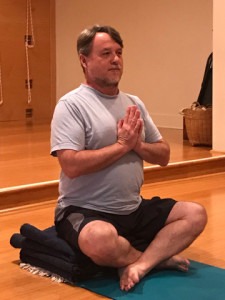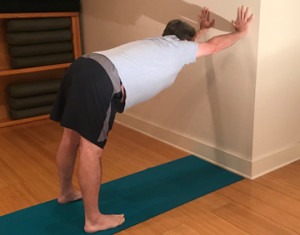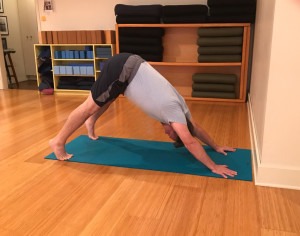David Sick has been practicing yoga at Evergreen for three years. He is a Professor of Greek & Roman Studies at Rhodes College. He regularly attends the Monday evening Men’s Class.
 Here, David describes his experiences with yoga and life. You’ll see how he practices and works on the pose called Adho Mukha Svanasana (Downward Facing Dog).
Here, David describes his experiences with yoga and life. You’ll see how he practices and works on the pose called Adho Mukha Svanasana (Downward Facing Dog).
“As an academic, I spend a lot of time in my head analyzing thoughts and ideas, and traditionally—especially in the West—we tend to separate the mind from the body, as if the two were almost enemies.
What I like about yoga, and particularly about the Iyengar method, is the focus on the cooperation of mind and body. The discipline of the asanas is a form of meditation, and that meditation releases the mind from other troublesome thoughts.
And as a bonus, the practice is good for my physical health as well! I can’t say I’m completely out of my head while at the sessions at Evergreen, but I’m working at it. Did you know that śvan- ‘dog’ from adho mukha śvānāsana is related to canis in Latin and κύων in Greek? See, that’s what I mean, not completely out of my head!” — David Sick
Below, David demonstrates a few of the ways he has been working on Downward Facing Dog Pose (Adho Mukha Svanasana):
Above, he warms up with Triangle Pose (Utthita Trikonasana) to strengthen and stretch the hips and legs.
Above, David practices an introductory pose leading to Dog Pose. This pose makes Dog Pose come more easily. Tightness in the backs of the legs and shoulders make this a challenge to many men. David works with it well, and has become more flexible over time.
See how he presses his hands into the wall with his fingers spreading.
Here, David turns his hands out to get the proper shoulder stretch. Now the hands are ready to be weight-bearing when he lifts his hips up.
Once you’ve learned a pose, it’s important to keep challenging yourself to improve and refine the poses! Practicing poses in different ways helps you isolate muscles that need stretching, firming and strengthened. In Downward Facing Dog, you learn how to use your arms and legs in order to lengthen your spine and trunk.
Here are some ways to practice, so that the pose continues to improve:
David bends his legs here — helping him to feel more extension in his spine. He also is able to work on the muscles of his upper back — which contributes to better posture when he walks, sits, stands and goes about his daily activities.
Our rope wall provides traction and supports the stretch of this pose. He loops the rope around his hips and hangs. He still uses his arm strength, but the hands/arms are bearing less of the weight. He can feel the spinal extension and work on flattening his palms.





